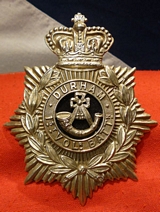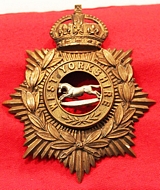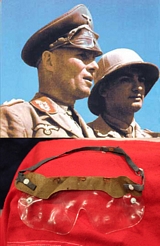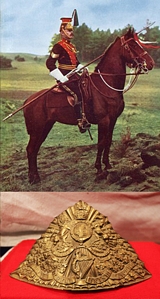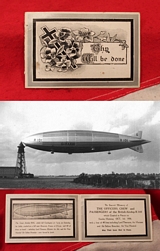A Victorian Durham Light Infantry Helmet Plate Ist Volunteer Battalion
In white metal with black centre. The 1st Durham Rifle Volunteer Corps was formed at Stockton-on-Tees in 1860, and in 1880 was amalgamated with other Durham corps, from Darlington, Castle Eden and Middlesbrough, to form a battalion of eight companies.
The 1st Durhams later became the 1st Volunteer Battalion of the Durham Light Infantry and as such gained the battle honour `South Africa 1900-02' for the services of its members during the Boer War. read more
175.00 GBP
An Edwardian West Yorkshire Regt. Large Helmet Plate
World War I saw numerous battalions of The Prince of Wales's Own (West Yorkshire Regiment) serving at Neuve-Chappelle, Loos, the Somme, Passchendaele, Ypres, Marne, Arras, Cambrai and Gallipoli. At its peak The West Yorkshire Regiment numbered 37 battalions, 66 Battle Honours were bestowed and four Victoria Crosses were awarded.
The four TF battalions formed the West Yorkshire Brigade, which mobilised as 146 Brigade, 49th (West Riding) Infantry Division on the outbreak of World War I and served in France 1915?18. They raised duplicate battalions (2/5th, 2/6th, 2/7th, 2/8th) that constituted 185 Bde in 62nd (2nd West Riding) Division, which also served in France 1917?18. In 1915 they formed further reserve battalions (3/5th, 3/6th, 3/7th, 3/8th) Battle honours in WW1 The Great War [31 battalions]: Aisne 1914 '18, Armenti?res 1914, Neuve Chapelle, Aubers, Hooge 1915, Loos, Somme 1916 '18, Albert 1916 '18, Bazentin, Pozi?res, Flers-Courcelette, Morval, Thiepval, Le Transloy, Ancre Heights, Ancre 1916, Arras 1917 '18, Scarpe 1917 '18, Bullecourt, Hill 70, Messines 1917 '18, Ypres 1917 '18, Pilckem, Langemarck 1917, Menin Road, Polygon Wood, Poelcappelle, Passchendaele, Cambrai 1917 '18, St. Quentin, Rosi?res, Villers Bretonneux, Lys, Hazebrouck, Bailleul, Kemmel, Marne 1918, Tardenois, Amiens, Bapaume 1918, Drocourt-Qu?ant, Hindenburg Line, Havrincourt, ?p?hy, Canal du Nord, Selle, Valenciennes, Sambre, France and Flanders 1914-18, Piave, Vittorio Veneto, Italy 1917-18, Suvla, Landing at Suvla, Scimitar Hill, Gallipoli 1915, Egypt 1915-16 read more
220.00 GBP
A Pair of WW2 Gas Shield Eye Protectors, Afrika Korps Dessert Campaign Souvenirs, 'Rommel' Type
Made for the British forces in the earliest part of the war, initially as gas protectors, but actually soon realised to be far better as sand storm eye protection, made of an early form of clear celluloid with elastic.
Used to great effect by our so-called Desert Rats in North Africa, but many were captured in the early part of the war in Afrika by the German forces, and re-issued and used by them. In fact Rommel used the very same protectors for that purpose as one can see from the numerous photos of Rommel taken in Africa.
Part of a collection of Afrika Korps campaign souvenirs, including the tinted celluoid goggle type, and a complete pack of goggles, in all original packing, very rare to survive complete packet and contents read more
55.00 GBP
Many Wonderous Pieces Added Every Day. There is Probably Nowhere Else In The World You Can View Such Fabulous & Historical Wonders,.. & Where Everything Is For Sale
All under one roof, intriguing and collectable artefacts, and specialist 1st edition rare books, plus militaria such as, an original, huge, and very rare 88mm WW2 Shell from a German 'King Tiger' tank, ranging to an original Imperial Roman Legionary’s gladius sword, a museum quality samurai sword by one of the great sword makers of early 14th century Japan. Or, a most rare, and absolutely stunning museum grade Christian samurai’s sword from circa 1630.
These past few weeks we have added, and are still adding, original, ancient artefacts, from Rome, France, Carthage, Persia, Greece, and Britain, many from fine English collections, originally acquired in the early 19th century, and then re-acquired from the descendants of those original collectors, in the 1990’s or even before by other collectors who subsequently sold them to us.
We have thousands of pieces, that you can can view [and buy] from our website. View and buy such treasures as a 2000 year old roman soldier's gladius sword, from the time of Julius Caesar, Augustus and Nero. A museum grade 1000+ year old sword of a Viking chieftain, king or earl [in Viking times called a jarl] that is inlaid with traces of knotwork silver inlay. A bronze and iron Archemeanid sword from the time of the Greco-Persian wars of Xerxes the Great against the Spartans at Thermopylae, or a Circa 2,500 Scythian infantry warrior’s bronze helmet. Plus, Imperial Roman 1st and 2nd century rings, the type such as worn by a Roman freed gladiator, or, the owner of slave gladiators, the Imperial Pretorian Guard, legionary officer's or nobles, often with the traditional symbols and figures, from the time of the Emperors Augustus, Tiberius, Caligula, Claudius and Nero. A superb 3rd to 4th century BC Falcata sword similar to the Greek Kopis, the sword used by Hannibal’s army in the 2nd Punic War and his invasion of Rome across the Alps, and a 3rd Century Imperial Roman Sword, from the time of Emperor Constantine and the Battle of Cibalae. Plus a remarkable 900 to 1066 period Original Viking- Norman Iron Four Plate Helmet, as seen depicted in the world famous so-called Bayeux Tapestry, plus, early and rare books, such as, an original very early printing of a 5th century Roman treatise on Roman warfare, and an 18th Century biography on 18th century Warfare, or a very rare 15th century incunabula by Bartolomeus Platina personally commissioned by Pope Sixtus IV.
Plus, as usual, many, many thousands of pieces of historical interest, from one of the oldest and still thriving [if not the oldest surviving] traditional, purveyors of original ancient, antique and vintage historical militaria, companies in Europe, family based through generations in the city of Brighton, and for over 100 combined years located in the Brighton Lanes.
Our family partners Mark and David have dedicated between them, a combined 90 plus years together, serving the world's collectors. Some are the simplest of collectors, some with most eclectic tastes, covering all fields of interest spanning millennia, others, highly specific, if not profound. Very recently we found for a specialist book collector a most rare ‘Subscriber’s Edition’ 1926 Seven Pillars of Wisdom, by T.E. Lawrence, a book that the collector had been searching for for 20 years, and we had joined in that search for him around 10 years ago. He had seen two volumes of that edition around 10 years ago, but discounted both of them, as not quite the perfect volume he was looking for. The dedication of a collector who could spend 20 years to find a single book, that specifically suited his needs, is simply remarkable, although strangely, not that unusual in our line of country. Despite the fact that the book we found for him was approaching six figures, he actually had spent over twice that sum during his 20 year worldwide search to find just the perfect one he was looking for. When asked by us which specific book he was seeking of that printing, he replied that he didn’t actually want or need a perfect condition example at all, just the one that was perfect for him “ I am not entirely sure which one I seek, but I’ll know it when I hold it”
The best part of our field is that, in the most part, of all of what we regularly offer can be remarkably affordable compared to almost every other form of fine and rare collectable. For example, the best available fine art paintings etc. can run into millions, even hundreds of millions of pounds, the finest pieces of furniture can run into hundreds of thousands or even millions, the best silver, coins or stamps can also be worth millions, and even 20th century motor cars can reach tens of millions of pounds. So although some of our pieces might appear expensive, by comparison to almost every other field in the world of collecting, they can be amazingly affordable to all and every rank of collector.
We suppose that is our raison d’etre, every year we buy many thousands of pieces, and pass them on to similarly thousands of collectors, from postmen to presidents, from Chelsea pensioners to field marshals, from law clerks to Lord Chancellors. I [Mark] remember one such interesting and jolly conversation, I and my wife Judith had over lunch, with the soon to become Lord Chancellor Quentin Hogg, in Jermyn St., during our London honeymoon in 1978. Judith had, on occasion before our marriage, worked with Sir Michael Havers, [Quentin’s successor as Lord Chancellor in 1987] so they had mutual acquaintance. The general chit chat got around to the efficacy of hanging, the effectiveness of the hangman’s knot, against the much earlier system of the executioner’s axe that was only afforded only to those of high status!. Quentin remarked at the conclusion [tongue in cheek] “ I have a little list of likely candidates, just in case it is re-introduced”
By way of coincidence, a few years later we sold a 16th century executioner’s axe to a ‘Beefeater’ Yeoman Warder of the Tower of London, Geoffrey Abbot, near identical to one that executed Lady Jane Grey, who was proclaimed Queen of England in 1553, reigned for just 9 days and subsequently executed within the grounds of the Tower, aged just 16 or 17, and our former axe appears amongst other places, illustrated in his books on the execution at Tower of London. He was even consulted some years later for the execution of Saddam Hussein.
Many of our collectors have become lifelong and dear friends, with conversations on every subject imaginable, covering every conceivable avenue of interest, and it has been a privilege to know every single one, friendships valued beyond pearls. read more
Price
on
Request
A Fine & Original Chapka Plate for the 9th Royal Lancers WW1 Issue
With all battle honours up to the Boer War. The last Lancer regiment to engage in Lance on Lance combat in WW1. The chapka was a type of helmet worn by 19th century Polish light cavalry and later adopted by another nations, including Britain.
During the Second Boer War, 1899-1902, the Lancers took part in the following actions: Belmont, Battle of Modder River, Magerfonstien, Relief of Kimberley, and the following Battle of Paardeberg which resulted in Cronje?s surrender. They provided Lord Roberts? escort for his state entry into Bloemfontein. After the war, the 9th returned to Sialkot in the Punjab Although engaged in combat for the whole of the war the Lancers only operated as a cavalry unit during 1914. This was due to the widespread use of machine guns and shelling and also the advent of the tank. For the remainder of the war they operated as infantry in the trenches.
Notable events included a Victoria Cross for Captain Francis Octavius Grenfell for his actions in saving the guns of 119th Battery, Royal Field Artillery on 24 August 1914 (he was later killed in action on 24 May 1915, as was his twin brother, Riversdale, a yeomanry officer who attached to 9th Lancers), and the regiment's participation in the final "lance on lance" action of the First World War on 7 September 1914 at Moncel in which Lieutenant Colonel David Campbell led a charge of two troops of B Squadron and overthrew a squadron of the 1st Guard Dragoons. After Campbell left on promotion he was replaced as commanding officer by Desmond Beale-Browne.
.
By the end of the war 274 Lancers had died.
In August 1914 Hume's regiment was in Belgium with the British Expeditionary Force (BEF). On 24 August during the Battle of Mons, they charged a large body of German infantry who were advancing to encircle the 5th Division at Audregnies. This famous action saw Captain Francis Grenfell win the Victoria Cross. The 9th Queen's Royal Lancers, or the Delhi Spearmen, were a cavalry regiment of the British Army. They are best known for their roles in the Indian mutiny of 1857, the WW1 Charge at Mons, and for their part in the North African campaign of World War II including the retreat to and the battle of El Alamein in 1942.The 9th Queen's Royal Lancers were originally formed during the Jacobite Risings in 1715. They were formed by Major-General Owen Wynne and were the second cavalry regiment in the British Army. They were initially known as the "9th Dragoons" or "Wynne's Dragoons". In 1717, the regiment embarked for Ballinrobe, in Ireland, and was placed on the Irish establishment.
In 1783 they converted into Light Dragoons, becoming the 9th Light Dragoons, and served in the Irish Rebellion of 1798, Sir Samuel Auchmuty's expedition to the River Plate in 1803, the occupation of Montevideo and Wellington's Peninsula War between 1811 and 1813.
In 1816 they were constituted Lancers and in 1830 were given the distinguished title of "Queen's Royal", in honour of Queen Adelaide, consort of William IV, hence becoming the 9th Queen's Royal Lancers.
The Lancers were first posted to India during the Gwalior Campaign of 1843. They subsequently took part in the First Anglo-Sikh War of 1845-46 and the Second Anglo-Sikh War of 1848-49 where they were often led by Sir Hope Grant and were the first recipients of the Bronze Star Medal.
During the Indian mutiny of 1857, the 9th Lancers earned the name the Delhi Spearmen, a name which is believed to have been given to them by the mutineers themselves. 9th Lancers was present in all three of the most notable events associated with the Indian mutiny, namely, the seizure of Delhi, the seizure of Lucknow and the relief of Lucknow. For their actions the Lancers were awarded twelve Victoria Crosses, more than any other cavalry regiment. They were described by an ally as:-
"The beau ideal of all that British Cavalry ought to be in Oriental countries". read more
295.00 GBP
A Good Victorian Fifth Royal Irish Lancers Tchapka Helmet Plate
In superb condition, fabulous bronze patina and two helmet screw posts.Queen Victoria's crown. The regiment was originally formed in 1689 as James Wynne's Regiment of Dragoons. They fought in the Battle of the Boyne and at the Battle of Aughrim under William of Orange. Renamed the Royal Dragoons of Ireland, they went on to serve with the Duke of Marlborough during the Spanish War of Succession and earned three battle honours there.In 1751, they were retitled 5th Regiment of Dragoons and in 1756 the 5th (or Royal Irish) Regiment of Dragoons. As such, they served in Ireland and were active during the Irish Rebellion of 1798. However, they were accused of treachery; their accusers claimed their ranks had been infiltrated by rebels. (According to Continental Magazine, April 1863, the unit refused to attack a group of rebels.) This accusation appears to have been false, but nevertheless they were disbanded at Chatham in 1799. The regiment was reformed in 1858, keeping its old number and title, but losing precedence, being ranked after the 17th Lancers. It was immediately converted into a lancer regiment and titled 5th (or Royal Irish) Regiment of Dragoons (Lancers). In 1861, it was renamed the 5th (or Royal Irish) Lancers and then the 5th (Royal Irish) Lancers. The regiment served in India and a section served in Egypt in 1885, taking part in the battles at Suakin. It served with distinction in the Second Boer War from 1899 to 1902, gaining battle honours at Battle of Elandslaagte and The Defence of Ladysmith.
The regiment then returned to England where it stayed until the outbreak of World War I, when it became part of the British Expeditionary Force and saw action continually from 1914 to 1918 in some of the war's bloodiest battles. During the battle of Bourlon Wood George William Burdett Clare received the Victoria Cross posthumously. The 5th (Royal Irish) Lancers won a total of 20 battle honours during the Great War.
The 5th (Royal Irish) Lancers also has the grim honour of being the regiment of the last British soldier to die in the Great War. This was Private George Edwin Ellison from Leeds, who was killed by a sniper as the regiment advanced into Mons a short time before the armistice came into effect.
The regiment was renamed 5th Royal Irish Lancers and disbanded in 1921, but a squadron was reconstituted in 1922 and immediately amalgamated with the 16th The Queen's Lancers to become the 16th/5th Lancers The Royal Irish Lancers were in Mons at the time of retreat in 1914 but escaped and returned on Armistice Day. The last cavalry regiment out and the first back!. The memorial panel we show in the gallery records the return welcomed by the Maire and the Cur?. The scene is taken from a painting, ?5th Lancers, Re-entry into Mons?, last heard of in the private collection of a Belgian citizen. This in turn is almost a mirror image of a painting ?5th Lancers, Retreat from Mons? (whereabouts unknown). In the former, the troopers are heading in the opposite direction to the ?Retreat?, and a middle-aged priest and a pregnant woman watching the departure of the regiment among a worried-looking crowd of Belgian citizens have subtly changed: the priest is now white-haired and the mother holds up her four-year-old child, having lived through the occupation of the German forces in Mons for four years. The Great War 1914
The 5 Lancers, as part of the 3rd Cavalry Brigade, were heavily involved and played a major role in the initial mobile actions fought by the BEF. They gained the distinction of being the last cavalry regiment to withdraw from Mons during the retreat; they also had the privilege to be the first British regiment to re-enter Mons after the pursuit in November 1918. Generally the First World War is described as a war of trench deadlock primarily fought by the infantry, gunners and engineers, this assessment is correct. It must however be remembered that cavalry regiments were expected to take their place in the line from time to time and did share the privations of trench warfare suffered by the infantry. On a number of occasions 5 L particularly distinguished themselves: in the defence of Guillemont Farm, June 1917, 3 MCs, and 4 MMs were won and during the defence of Bourlon Wood in 1918 Private George Clare won a posthumous VC. While the main focus of the First World War remained with the armies fighting on the western front it was by no means the only theatre of war. In 1918 Allenby, a 5th Lancer and later a Field Marshal, reorganised British forces in the Middle East pushing his lines forward into northern Palestine. Allenby's Army broke through at Megiddo resulting in the collapse of Turkish resistance. 8.25 inches x 5 inches approx. read more
295.00 GBP
An R.101 Airship Catastrophe Crash Memorial Service Card
On October 5, 1930, the British airship R.101 crashed on a hill in Beauvais, France. The impact was gentle and survivable but the ship was inflated with hydrogen, and the resulting fire incinerated 46 of the passengers and crew. Two additional crew members died of their injuries soon after. The ship had never been flown at full speed, or on all engines, or in bad weather. But on October 4, 1930, the ship was dispatched to fly on all engines into a known storm, at a time of year known for bad weather, despite the recommendation of airship officers and meteorology experts.
After struggling to maintain altitude over England and the Channel the ship crossed into France, where rain and wind damaged the unrepaired fabric at the nose of the ship and broke open gas bags in the bow, releasing the ship?s lifting gas. The overloaded and under-ballasted ship settled into a hillside in northern France and moments later the ship?s hydrogen erupted into flame. Calcium flares in the control car may have ignited, activated by exposure to water, but whatever the source of ignition, the fire destroyed the ship in minutes and killed most of those onboard, including Lord Thomson. read more
35.00 GBP
A Good & Scarce, Victorian, 12th Lancers Helmet Plate With Battle Honours
In patinated brass. With two screw posts. With it's Victorian, pre Boer War battle honours; Egypt, Salamanca, Peninsula, Waterloo, South Africa 1851-2-3, Sevastopol, Central India. The regiment of dragoons that was to become the 12th Royal Lancers was raised by Brigadier-General Phineas Bowles in Berkshire in July 1715 against the threat of the Jacobite rebellion. In 1718 the regiment was placed on the Irish establishment and posted to Ireland, where it remained for seventy-five years.
In 1751 the regiment was officially styled the 12th Dragoons. In 1768 King George III bestowed the title of The 12th (Prince of Wales's) Regiment of (Light) Dragoons, the regiment was given the badge of the three ostrich feathers, and the motto "Ich Dien". The 12th Dragoons, led by General Sir John Doyle won their first battle honour in Egypt in 1801 against the French Dromedary corps.[3] They had previously had a young Duke of Wellington serve with them as a subaltern between 1789?91. In 1816, the 12th Light Dragoons were armed with lances after the cavalry of Napoleon's Army had shown their effectiveness at Waterloo and were re-titled 12th (The Prince of Wales's) Regiment of (Light) Dragoons (Lancers). In 1855 they reinforced the Light Cavalry Brigade in the Crimea after the Charge of the Light Brigade at Balaclava. In 1861, they were renamed 12th (The Prince of Wales's) Royal Regiment of Lancers. Between 1899 - 1902 they fought in the South African War, taking part in the Relief of Kimberley and Diamond Hill, the last battle of the war. read more
245.00 GBP
A Very Nice Original Simkin Watercolour of an Officer 2nd Lifeguards 1876
Simkin was born in Herne Bay, Kent, on 5 November 1850, (some references cite 1840) the son of a commercial traveller, also named Richard. After marrying his wife, Harriet, in 1880, He spent much of his time at Aldershot, Hampshire, and may also have been a volunteer in the Artists Rifles. He was employed by the War Office to design recruiting posters, and to illustrate the Army and Navy Gazette. In 1901, he created a series of 'Types of the Indian Army' for the Gazette. he obtained much of the information from the Colonial and India Exhibition of 1886. During his lifetime, he, along with Orlando Norrie produced thousands of watercolours depicting the uniforms and campaigns of the British Army. Simkin also contributed illustrations to numerous publications including the Boy?s Own Magazine, The Graphic and others; many were published by Raphael Tuck and sons.
He died at his home at 7 Cavendish Street, Herne Bay on 25 June 1926, survived by his wife and two daughters. Today, his pictures can be seen in numerous regimental museums and his illustrations appear in regimental histories, 7 inches x 9.8 inches read more
595.00 GBP
1928 Graf Zeppelin Plaque of the LZ127 Graf Zeppelin. By Heinrich & Co.
A Rare 1928 Graf Zeppelin Porcelain Wall Plaque
Depicting the LZ127 Graf Zeppelin. By Heinrich and Co. Inscribed on the reverse Forrngebung Fachoberiehrer, W-Veit Decoration Facheihrer Otto Keitel, Entwurf begutachtet una genehmigt von der Luftshiffbau Zeppelin Gmbh Friedrichshafen 1928, Ges Geschutzt -- 9.75in. (25cm.) diameter
The LZ-127, Graf Zeppelin, was arguably the most important zeppelin ever, the airship that put post WW I German aviation back on the map. Ferdinand Graf von Zeppelin inaugurated German lighter-than-air aviation at the turn of the 20th Century. His zeppelins caught the German public?s imagination, and they became extremely popular. During WW I, his zeppelins flew for both the Army and Navy. Once more, the zeppelins caught the German people?s imagination. Even civilians and military officers who were bombing targets, both on the continent and in England, were impressed by the giant machines. Graf von Zeppelin died in 1917, and his company, which passed to Hugo Eckner?s management, faced difficult times in post WW I Germany. As a part of Germany?s war reparations, the Zeppelin Company built and delivered the LZ-126 (eventually renamed the U.S.S. Los Angeles) to the U.S. Navy in 1924. Eckner personally commanded the LZ-126 on the flight to the U.S. The engendered excitement allowed the company to build the LZ-127, eventually known as the "Graf Zeppelin." It was placed in service in 1928.
The Graf Zeppelin remained in service from September 1928 until a month after the Hindenburg exploded in New Jersey in May 1937. During this time, the "Graf Zeppelin" flew almost six hundred flights and covered more than one million miles. With the destruction of the "Hindenburg," the zeppelin era sadly came to an end. During her nine years of flight, the LZ-127 circled the globe, flying from Europe to the USA and on to Asia. She even had numerous voyages to South America. It was travel on a grand scale for less-than-thirty lucky people at a time. A crew of about twenty-four served the passengers. Trips from Germany to the U.S. were much faster than any other vessel of the time. Life aboard the "Graf Zeppelin" was very gracious. read more
875.00 GBP


